IJN Heavey Cruiser Atago : Operation Shoho
Atago was the flag of Admiral Kurita. He headed to the Leyte Sea of the Philippines with a huge fleet to stop MacArthur's troops from landing in the Philippines. At 6:32 a.m. on October 23, 1944, the USS Darter fired six torpedoes at Atago, four of which were hit. Twenty minutes later, Atago capsized and sank with 360 soldiers.
1/700 Scale
Manufacturer : Fujimi
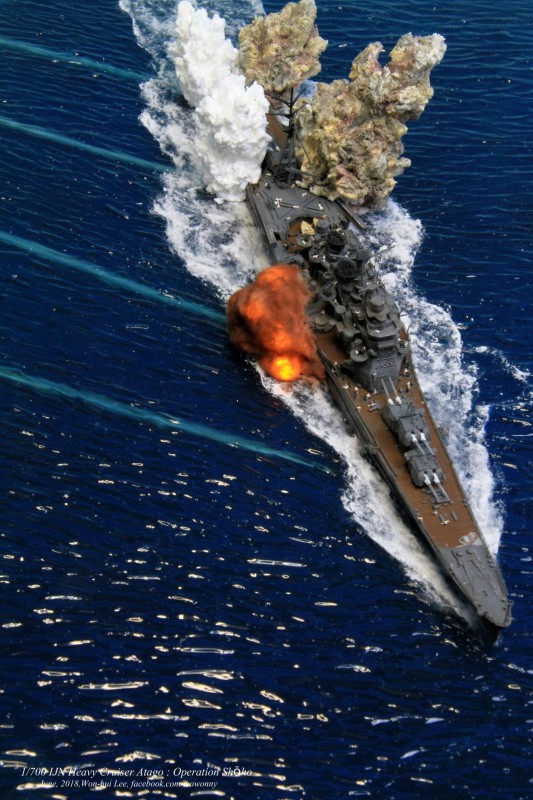
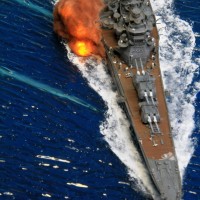

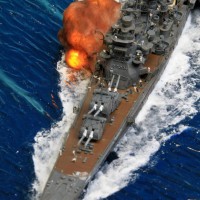
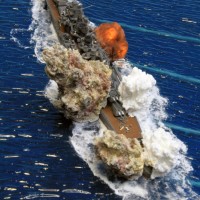
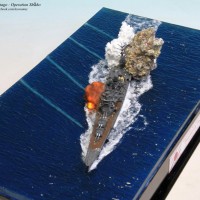

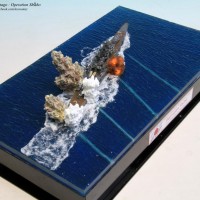
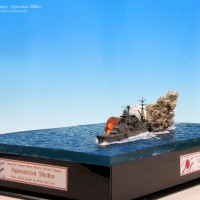
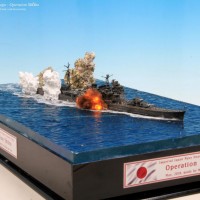
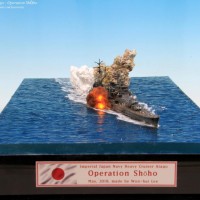
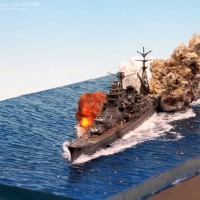
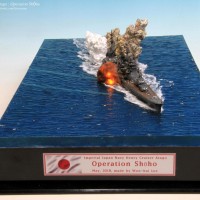
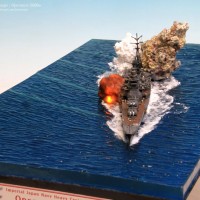
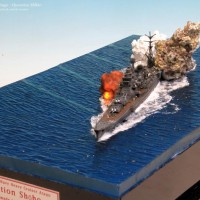
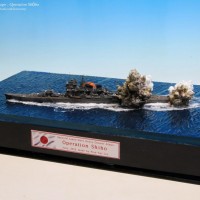
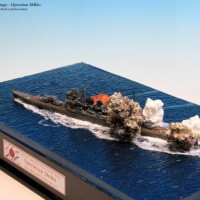
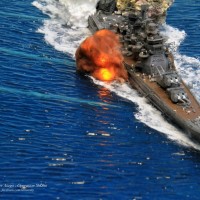
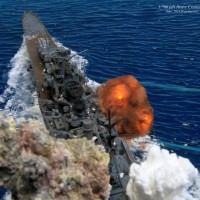
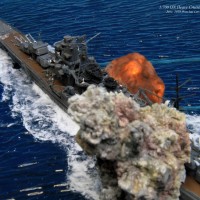
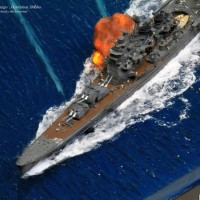
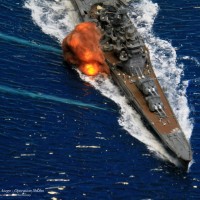
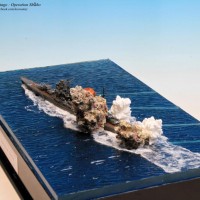
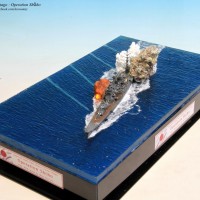
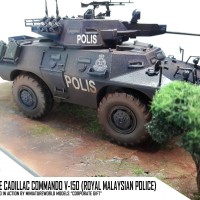
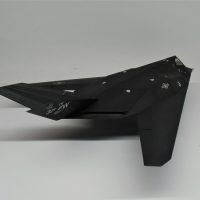
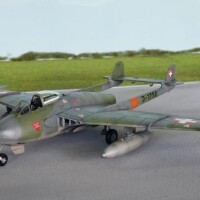

Very nice Won-hui! Your usual museum standard. Thanks also for honoring the history and sharing it with us!
Thank you very much.
Of all the projects you have done, Won-hui, this is the most incredible (at least to me). Just stunning in its "you are there" realism.
In case anyone wonders whether or not "a picture is worth 10,000 words," here's my description of the event in "Pacific Thunder." I'm pretty sure Won-hui wins.
"Anticipating a Japanese response to the invasion, American submarines were positioned at strategic locations west of the Philippines. Commander David H. McClintock’s USS Darter (SS-227), and Commander Balden D. Claggett’s USS Dace (SS-247), operated as a wolfpack under Claggett’s command near the Palawan Passage. They were an early-warning force, with orders to notify Seventh Fleet of any Japanese naval forces found.
"The battle of the Palawan Passage began at 2355 hours on 23 October when lookouts aboard Darter spotted the Center Force as the Japanese passed Palawan Island. Skipper McClintock contacted Dace with the message, “Fast ships on northeasterly course.” At 0016 hours on 24 October, the fleet was picked up on Darter’s radar as a large blip, range 30,000 yards. The radar operator at first mistook the contact for a rain storm at the southern entrance to the Palawan Passage, but quickly realized his mistake.
"Darter submerged and McClintock kept the radar above the surface as he searched through the periscope. He soon found the enemy. The enemy was zig-zagging, but incredibly the ships were still in steaming formation without a defensive antisubmarine screen. Once the Japanese passed, McClintock came to the surface and warned Dace of the oncoming enemy, then sent off a contact report to ComSubSoWesPac and Seventh and Third Fleets.
"Dace’s captain Clagett ordered a change of course and brought the engines to full power on receipt of Darter’s warning. His plan was to pass the enemy and get into position at the far end of Palawan Passage. Both submarines surged through Palawan Passage at 21 knots, in close enough formation that the commanders could communicate by megaphone. They quickly planned a “hammer and anvil” attack at dawn at the point where the Japanese would enter the Sibuyan Sea. The only way they could get into position in time was to take a “short cut” across “The Dangerous Ground,” an area of the passage with uncharted reefs to either side, while the Japanese continued on in the main channel. They accomplished this difficult feat and separated at the passage’s exit, with Darter moving south of the oncoming enemy and Dace to the north.
"McClintock sounded “Battle Stations” at 0500 hours. Crewmen not already at their stations moved quickly into position. Ten minutes later, Darter disappeared into the dark waters of the passage as McClintock submerged and headed toward the enemy fleet. Dace moved into position and submerged five minutes later. The gray pre-dawn light allowed both commanders to spot the targets through their periscopes.
"Darter fired six torpedoes at the nearest cruiser when the fleet zigged toward her at 0530 hours. With range only 930 yards, it was barely a minute before numbers two, three, four and five struck Kurita’s flagship, the heavy cruiser Atago, on her port side from bow to stern, setting her on fire in multiple locations. McClintock reported, “Whipped periscope to the first target to see the sight of a lifetime. Cruiser was in so close that all of her could not be seen at once with periscope in high power. She was a mass of billowing black smoke from No. 1 turret to the stern. Cruiser was already going down by the bow.”
"McClintock then turned and fired his four stern tubes at a second heavy cruiser. They arrowed past the burning Atago and hit the stern of heavy cruiser Takao at 0540 hours, which damaged her propulsion.
"Eighteen minutes later at 0558 hours, Atago went down with 360 of her crew. Admiral Kurita chose to go down with her, but he was rescued in the water by his staff, who convinced him to carry on the fight. The admiral was pulled from the water by a destroyer, then transferred to Yamato. Never a believer in the the operation’s success, Kurita was a shaken man when he ordered two destroyers to escort Takao back to Brunei.
"Aboard Dace, Commander Claggett watched saw Atago sink and Takao listing, badly damaged. “It looks like the Fourth of July out there!” he shouted to everyone in the conning tower. “One is sinking and the other is burning. The Japs are firing all over the place. What a show!” After allowing two smaller ships to pass, he then took aim at what he identified as a Kongo-class battleship and fired all six bow tubes at 0556 hours. Four hit the heavy cruiser Maya in her torpedo stowage and she blew up immediately, sinking quickly with heavy loss of life.
"Too late, the destroyers went after Dace while Darter slipped away undiscovered. Claggett ordered, “Take her deep.” Soon Dace was shaken by explosions “as if the ocean bottom was blowing up.” The explosions were followed by a noise that Executive Officer LCDR Rafael Benitez described as “Gruesome. It was akin to the noise made by cellophane when it is crumpled.” The crackling noise was so loud, it sounded like the submarine was breaking up and Claggett had all compartments checked. To everyone’s relief, there was no damage.
"Aboard Darter, the sound man gave a running narrative of the action. “Four of them are making a run now, Captain.” The destroyers “sounded like an electric razor at work on a two-day beard.” Everyone could hear them approach but only the sound man could tell how many there were. The remainder of the Center Force headed into the Sibuyan Sea while the depth charging continued. “They were going off all around us and they were close,” Benitez recalled. Dace was rocked by the explosions while light bulbs shattered and locker doors flew open. After 90 minutes of this, the destroyers moved off to rejoin the fleet.
"Darter and Dace surfaced and spotted the two destroyers escorting the damaged Takao and spent the rest of the day maneuvering submerged as they tried to get a shot at the cruiser. Takao finally came to a halt at sunset. Expecting the destroyers to tow the damaged ship, both submarine captains surfaced after nightfall to attack. Just as they did, Takao got underway under her own power. Attacking a moving target was different than shooting a sitting duck, even one only moving at six knots.
"The two captains decided to split their attack: Darter would wait to attack from the east while Dace made an end run around to attack from the west. Just before midnight, both were moving into position. As Takao picked up more speed, McClintock ordered Darter to increase speed to at 17 knots, as he attempted to attack before Takao could get away."
Now what I want to see you do,Won-hui, since you're the only modeler who could even think of trying this, is what followed:
"During the previous 24 hours, both submarines had navigated Palawan Passage by dead reckoning. Since they were submerged during daylight, neither navigator was able to get a fix on the mountains of Palawan Island. Thus, they were both uncertain of their exact position. The cloudy night prevented either getting a celestial fix.
"McClintock’s plan was to remain seven miles from Bombay Shoal, a coral reef on the passage’s western side. Unfortunately, due to a quarter-knot error in the estimate for the current, the submarine was on a collision course with the reef. At 0005 hours on 25 October, Darter’s crew learned why this stretch of water was called “the Dangerous Ground” when she ran hard aground on Bombay Shoal with a tremendous crash.
'When Dace received Darter’s distress call, XO Benitz recalled, “It was hard to give up pursuing a ship that we knew would probably sink with one torpedo hit, but it would have been doubly hard to abandon our comrades to certain death on the shoals of Palawan Passage.”
'Once she arrived at Bristol Shoal, Dace slowly and cautiously moved closer to Darter. Once she was within 50 yards of Darter’s stern, she sent over a line. Darter’s situation was hopeless. Benitez later wrote, “She was so high that even her screws were out of the water — she seemed like a ship in drydock.”
'As it soon became evident Darter would never get off the reef, her crew began burning secret documents and destroying vital equipment with sledgehammers. Both used their rubber rafts to bring Darter’s crew over to Dace, six at a time during the course of two and a half hours. Benitez wrote, “In the darkness, gnome-like figures on the deck of Darter were seen to go down her side into rubber boats awaiting them below. Minutes later, they reappeared at the side of Dace, where willing hands hoisted them aboard.” Commander McClintock was the last to leave, lifted aboard Dace at 0439 hours. He reported the demolition charges were set, and Dace moved away at full speed. Unfortunately only one of the charges went off, with a comical pop. Still intact, Darter would be useful to the Japanese if captured.
'Dace still had four torpedoes aboard. Two were fired at Darter but hit the reef. Dace moved directly astern and fired the last two, which also exploded against the reef. At 0530 hours the sun was rising. The two captains decided to destroy Darter with Dace’s deck gun. Dace’s gunners hit Darter 21 times, holing the superstructure and hull. When the radar operator reported an air contact at six miles and closing, Claggett immediately ordered, “Clear the deck!”
"Dace began to submerge as the 26 men on deck made a frenzied dash for the only open hatch, on the conning tower. Some climbed down but others fell sideways, dove head first, or were pushed down in a heap. The Officer of the Deck pulled the hatch closed seconds before the submarine went under. During the rescue operation and gun action, no one was lost.
"Spotting both submarines, one dead in the water, the other submerging, the Japanese pilot attacked the easier target. To the relief of all aboard Dace, he bombed Darter to no effect and flew off. Minutes later the submarine surfaced and set course for Fremantle, Australia. The 11-day voyage was difficult but uneventful, with 81 Darter survivors and Dace’s 74 man crew aboard. Men slept on empty torpedo skids and anywhere else not occupied. Two days before arrival, the only food left aboard was peanut butter and cream of mushroom soup. Dace arrived at Fremantle on 6 November. Everyone knew they were lucky to be alive. Darter remains high atop Bombay Shoal to this day."
Thank you for your detailed historical explanation. I think Darter's achievements were very meaningful.
Pictures of the event.
2 attached images. Click to enlarge.
wow..
A great job, very good explosions
REGARDS
Thank you very much.
Won-hui, some strong work being done here. I like how your explosions are different. Some show the moment of impact with a column of white water while others show the split second after the torpedo has entered the hull of the ship and is dirtied by the interior of the ship. Followed by the explosion where gun powder is involved and smoke and fire that accompany that type. Then there are the trails of air bubbles left behind from the torpedo's.
The ship has all the rigging and the work done with the waves and the movement of water around the bow and sides is excellent...I could go on but, I would be repeating myself. A lot a time,effort and thought went into the making of this model and it shows. Its all in the details. A real contender for "Model of the month." You have my vote.
Two thumbs up.
Once again, your talent(s) shine through, sir...amazing craftsmanship indeed.
Another masterpiece depicting a sea battle. You do such great work at such a small scale.
I agree with all of the above statements! Wonderful work.
Won-hui,
your models take me back to the time I was looking in awe at my first contest table. I am not easily impressed these days, but your art is unique and inspirational.
Cheers!
Aleks
Hi!
I'm very impressived by your diorama!
I would like to know how to create sea.
Do you mix paints in with epoxy or paint colors on a base?
Thank you